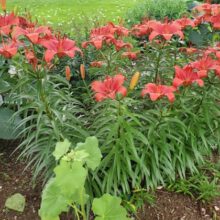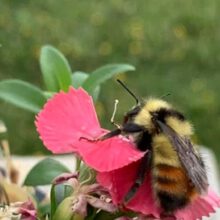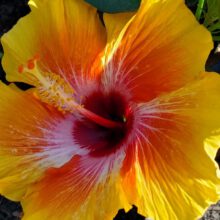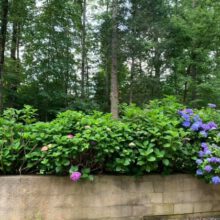A Guide Building An Orchard Garden
Apples and pears complete an authentic yard. Fall/winter is the time to plant fruit trees. Country life helps you get started with the construction of your orchard.
- Plan your orchard in a sunny place.
- Prepare a plant plan and a scale drawing in advance.
- Choose local as well as old varieties.
- Choose trees on a seedling rootstock.
- Choose varieties that pollinate each other.
- Plant pears and apples at a standard distance of 8 x 8 or 10 x 10 meters.
- Plant plums 6 x 6 meters away.
- For a less tight construction: use variable planting distances with a difference between large and small varieties.
- You can plant until middle in April.
- First place the tree pole on the southwest side of the hole to be excavated.
- Dig a 40 x 40 x 40 centimeter planting hole.
- Mix one to one and a half pounds of lime through the soil for the planting hole.
- Shorten the branches of the saplings to three to four buds.
- Leave the roots of the saplings as short as possible uncovered.
- Plant at the same depth as in the nursery.
- A protector against venom is not an unnecessary luxury.
- Consider a hedge around the orchard. A full-grown hedge, certainly a hawthorn hedge, protects and can be beautiful..
- Mow the grass around the trees regularly.
- Keep the orchard sketch, with names and information on it.
- A “grip” of digested farmyard manure is sufficient. Do not put the manure against the trunk.
- Trees planted after January need extra water.
Crown Height
With a standard tree, the crown (branching) starts at 1.80 meters.
Having a half-stem at 1.40 to 1.60 meters.
At a low stem at 0.70 to 0.80 meters, calculated from the ground.
Choice of Types
Find out in the area which fruit trees have traditionally been common. Apart from the fact that it is nice to participate in the preservation and return of regional varieties, there is another advantage: you can be almost certain that the conditions for these varieties in your region are optimal. You may be able to taste some apple or pear varieties beforehand. These varieties are also generally less sensitive to diseases and pests and can be stored well.
Fruit trees are almost always grafted onto a root-stock, and the root-stock also influences the character of the tree. Commercial fruit growers like to work on “type” root-stocks, for example “type 106”. These come to a higher yield faster. On the other hand, they anchor less well in the soil and form a less attractive crown.
For an old fruit variety, a seeded root-stock is therefore preferable. A well-known supplier of seedling root-stocks is the German apple Bittenfelder. Seedling root-stocks give the tree a good anchorage in the ground and usually a nice full crown. It does take a few years longer for the fruit tree to bear fruit.
In order to bear fruit, the trees must be pollinated during the flowering period. Some fruit varieties are self-pollinating. Others need a different tree to be successfully fertilized. That does not necessarily have to be a tree of the same variety and sometimes it is even undesirable. Besides the trees having to bloom at the same time, it is important that the pollen from one tree “catches” on the blossoms of the other.
If you plant six or more different apple varieties, all trees will find a fertilizer in the orchard. If in doubt, ask the grower for advice.
Place
When choosing the most suitable plot, it is wise to take a good look at the surroundings. Tall family trees become large lummels and once grown, the orchard must fit naturally into the landscape.
Do you want your yard to be authentic? In the past, an orchard was usually located in front of or directly next to the farm, so it could be seen from the road. Keep in mind that fruit trees need a lot of sun. Think about how the light will be and whether the trees will not be shaded by, for example, large oak trees.
Fruit trees do not place high demands on the soil. Fruit trees grow less quickly on poor soil than on oily (nutrient-rich) clay soil. The soil is not easily too dry or too wet. In a dry environment, however, it is important that the young trees are started up with some extra water in the first few years. For a while “wet feet” in winter is not a problem, but in summer there should be no water in the orchard. If there is a chance of that, plant the trees on a mound. This was also done in the past.
Planting
It is important to plant the trees at a sufficient distance from each other. After all, the thin blades of today will grow into trees with majestic crowns within a few decades. Light and air around the trunks improves their health and promotes ripening of the fruit.
A planting distance that is sufficient for most apples and pears is 8 by 8 to 10 by 10 meters. Plums need only 6 by 6 meters. In the past, fruit trees were usually planted in a tight pattern. Not only did this look neat, it also made it easier to maintain the orchard. Nowadays people sometimes plant in a “wild context”. Some find it more fun to look at, others view it more practically and take advantage of the fact that smaller breeds take up less space than larger ones. By planting them alternately, a less tight connection will automatically develop.
Winter is the best time to plant fruit trees, provided it is not freezing. From mid-February, trees begin to form new roots. Use posts, such as electric fence posts, a long rope and a tape measure of at least 10 meters when setting out the planting plan.
After setting out, drill the holes for the tree posts with a ground drill (hand drill or machine drill). The posts are related to the most common wind direction, on the southwest side of the trees. The tree strap with which the trunks are attached to the pole will soon be able to “pull” but not “push”.
Now dig a hole of 40 x 40 x 40 centimeters at each post. Put the trees in the right place and prune them back a little if necessary. The branches can be shortened to three to four knots. The less leaves are formed the first year, the better. The trees then need less water and will catch on earlier. Now add one to one and a half kilos of lime to the pile of loose soil and slide a little of the mixture of soil and lime back into the hole. Then place the young fruit tree on top and check whether the tree is at more or less the same depth as the nursery. Keep the tree upright, fill the planting hole with the soil/lime mixture and “shuffle” with the trunk during filling so that the soil joins the roots. It is not normally necessary to add fertilizer or water during planting, only do this with very poor or very dry soil. After planting, tamp the loose soil with your foot, so that the roots and especially the hair roots make good contact with the soil.
Now fasten the tree and post together using a piece of tree band turned “eight” and a single normal nail. Finally, protect the young trunk with a sturdy food protector. Hares and rabbits love a juicy piece of bark, especially in winter. Do you want to fertilize with raw manure after planting? Make sure that the manure does not touch the logs.



